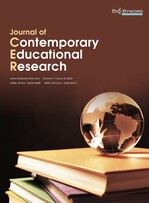Abstract
The Chinese paper-cut art, first recorded in the Wei, Jin, and Southern and Northern Dynasties (220 AD–589 AD), has witnessed the changes of times, yet it still retains its artistic vitality. Chinese papercuts can be divided into two schools: the northern and the southern. Jiangsu, located in the region of the Yellow River and Huai River, is the geographical dividing line between those two schools. Therefore, in Jiangsu Province, not only the rough northern art form (such as in Xuzhou papercut) but also the graceful southern art form (such as in Jintan papercut) is evident. In addition, the unique combined paper-cut style (such as in Yangzhou and Nanjing papercuts) can be appreciated here. Although several scholars have analyzed the artistic characteristics of Jiangsu papercut based on cultural background, very few have discussed the differences between the northern and the southern in terms of content, connotation, and style. Through literature review and collected works made by local craftsmen and inheritors of this tradition, this article aims to show readers the contrast and integration of papercuts in these four places under the influence of different cultural and economic backgrounds in order to better understand the role of regional factors in shaping the art form of papercuts in Jiangsu Province. Nowadays, with the change in people’s lifestyles, the living space of traditional papercuts has shrunk drastically, and its practicability in the past has faded. Instead, people are searching for and creating cultural and artistic value in museums, tourist attractions, and commodity transactions. Among them, some works have deviated from the cultural background of traditional paper-cut art. Therefore, this paper provides a basis for the current development of this art form in Jiangsu.
References
Zhang D, 1989, Traditional Arts and Culture: The Art of Chinese Papercuts, Beijing Language Press, Beijing, 1–2.
Chen J, 2007, History of Chinese Folk Paper-Cutting, Peking University Press, Peking, 91–95.
Wang X, 2013, Lucky Motifs in Chinese Folk Art: Interpreting Papercut from Chinese Shanxi, University of Illinois Press, United States, 1.
Huang B, 2017, The Cultural Connotation and Graphic Evolution of Fine Grain Paper-Carving in Yueqing. Decoration, 2017(01): 101–103.
Zhan L, Study on the Form Language of Yueqing Paper-Carving, thesis, Zhejiang Normal University, 9.
Xi’an Banpo Museum Compile, 1988, Ban Po Yang Shao Culture in General, Cultural Relics Publishing House, Beijing, 88–89.
Zhu K, 2009, Exploration and Research on the Traditional Folk Paper-Cut of Shaanxi Province, thesis, Jiangnan University, 10.
Li Z, Li T, 2009, Regional Characteristics of Chinese Folk Paper-Cut. Literary Theory and Criticism, 2009(05): 139–140.
Zhang L, Rong MJ, 2016, Preliminary Study on the Art Form of Jintan Paper-Carving. Modern Decoration Theory, 2016(08): 94–95.
Yang L, 2022, Through Han Stone Relief to Experience the Society and Life of Xuzhou. Ceramics Cultural, 2022(01): 6–9.
Yue P, 2020, Exploring the Art Form of Xuzhou Folk Paper-Cut. Beauty and Times, 2020(04): 47–49.
Liu Y, 2010, Analysis of Cultural Value of Xuzhou Folk Paper-Cutting. Popular Literature, 2010(01): 207–208.
Zhu X, 2021, Research on the Connotation of Folk Art. Shanghai Arts and Crafts, 2021(12): 26.
Bian H, 1991, Collection of Chinese local Chronicles, Jiangsu Fuxian Annals, Jiangsu Ancient Books Publishing House, Jiangsu, 169.
Ma C, 2019, Research on Paper-Carving in Jintan from the Perspective of Intangible Cultural Heritage, thesis, Jiangsu University, 84.
Jiantan Local Chronicle Office, Jintan Municipal Political Commission of Culture and History, 2007, Jintan and Its Stories, Fanzhi Publishing House, Beijing, 148–149.
Ma C, 2019, Research on Paper-Carving in Jintan from the Perspective of Intangible Cultural Heritage, thesis, Jiangsu University, 28–30.
Ma C, 2019, Research on Paper-Carving in Jintan from the Perspective of Intangible Cultural Heritage, thesis, Jiangsu University, 62–63.
Wang L, 2018, Study on Yangzhou Paper-Cut in Song, Yuan, Ming and Qing Dynasties. Beauty and Times, 2018(07): 33–35.
Liu J, 2013, Study on Yangzhou Paper-Cut Art, thesis, Hebei University, 15.
Gao H, 2009, Fine, Beautiful, Spirit, Elegant Yangzhou Paper-Cutting Art. MeiYuan (Beautiful Garden), 2009(10): 75–76.
Wang X, 2016, Yangzhou Paper-Cut in Latter-Day Times. Beauty and Times, 2016(06): 43–45.
Wang B, 2006, The History of Chinese Paper-Cut Art, Chinese Academy of Art Press, Hangzhou, 60.
Huang B, Cai X, 2019, The Cultural Implication of Zhangyongshou’s Paper-Cut Art. Folk Art, 2019(11): 122–125.
Li C, 2021, A Study Imitating Painting Phenomenon of Contemporary Yangzhou Paper-Cut, thesis, Yangzhou University, 77.
Huang H, 2018, Study on the History and Present Situation of Paper-Cut Art in Jiangsu and Zhejiang Province, thesis, Northeast University, 12.
Gan X, 2007, Baixiasuoyan (Stories in Nanjing), Nanjing Press, Nanjing, 36.
He J, Zhang C, 2015, Study on the Characteristic of Nanjing Paper-Cut. Beauty and Time, 2015(03): 61.
Gu Y, 2021, Finding Way of Traditional Paper-Cut’s Diversified Survival from the Factors of Local Origin – Taking Nanjing Paper-Cut as an Example. Artist, 2021(12): 90–94.
Cha Y, 2017, A Brief Analysis of the Artistic Style of Jiangsu Paper-Cut. Art of Inner Mongolia, 2017(09): 94–96.
